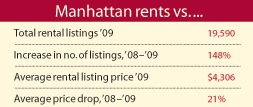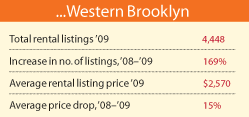Brooklyn has long been a haven for renters looking for cheaper deals than they can get across the river in Manhattan. In the current downturn, however, rents have dropped faster in Manhattan than in Brooklyn.
This month, The Real Deal stacks up the rival boroughs next to each other, comparing year-over-year rent drops to see where the biggest declines have been.
According to the real estate Web site StreetEasy, average rental listing prices fell 21 percent in Manhattan between the third quarter of 2008 and the third quarter of 2009, while coming down only 15 percent in Brooklyn.
In addition, price declines have been far steeper in certain Manhattan neighborhoods, a phenomenon that has made headlines and prompted many Brooklyn renters to give Manhattan another look. Indeed, brokers say, budget-conscious renters arriving in New York for the first time — who in the past may have gone straight over the Brooklyn Bridge to hunt for an apartment — are now weighing Manhattan as a comparable alternative.
 In Manhattan, the sharpest rent declines were in Soho, with prices coming down from a very high perch compared to most neighborhoods. Average listing rents there fell 36 percent in the third quarter of this year from the third quarter of 2008, dropping from $9,935 to $6,370, according to StreetEasy.
In Manhattan, the sharpest rent declines were in Soho, with prices coming down from a very high perch compared to most neighborhoods. Average listing rents there fell 36 percent in the third quarter of this year from the third quarter of 2008, dropping from $9,935 to $6,370, according to StreetEasy.
The East Village and the Lower East Side saw listing rents drop almost as much, down by 35 percent. In the East Village, average listing rents plummeted from $4,383 to $2,859, while on the Lower East Side they fell from $3,882 to $2,520, the data shows.
In contrast, the largest drop of the prime western neighborhoods of Brooklyn was in Carroll Gardens, which saw a 24 percent fall, from $3,422 to $2,615. That was followed by Windsor Terrace, where rents dropped from $2,593 to $2,061, and Boerum Hill, with a 20 percent fall, from $3,707 to $2,960.
StreetEasy’s data, which is primarily based on “open,” or publicly available, listings, is not entirely inclusive and doesn’t usually capture information about smaller, older apartment buildings, which tend to market their units more quietly. That could also skew the numbers toward bigger, more expensive buildings that are fresh to the market, perhaps explaining why the rental prices were somewhat high.
 As a result, there may be apartments, particularly in Brooklyn, that were not counted. If those units were counted, Brooklyn’s price declines might be deeper, brokers said. However, they would likely be offset by concessions, such as a few months of free rent, which has become popular in many new Manhattan rental buildings. And there are few comprehensive rental information sources out there.
As a result, there may be apartments, particularly in Brooklyn, that were not counted. If those units were counted, Brooklyn’s price declines might be deeper, brokers said. However, they would likely be offset by concessions, such as a few months of free rent, which has become popular in many new Manhattan rental buildings. And there are few comprehensive rental information sources out there.
It’s worth noting that Manhattan is still not a bargain. In the third quarter, its average rent was $4,306, which was 68 percent higher than Brooklyn’s, at $2,570, the StreetEasy data shows.
Nonetheless, brokers noted that rent declines can have a strong psychological effect.
“It looks like more of a bargain than it was before, even though apartments are still cheaper in Brooklyn,” said Steven Dunaif of Tower Brokerage, based in the East Village.
Dunaif said he thinks rents are probably down more like 17 percent in his neighborhood, not 35 percent as StreetEasy suggests. He also said that because of discounts, the number of his clients that are from Brooklyn has increased about 25 percent since the boom.
“If they went looking for an apartment when they were 22 years old,” now they’re back, Dunaif said.
The trend may be best measured at new buildings, as their renters are just now coming into the market, brokers explain.
For example, at 200 Water Street, a 576-unit Rockrose conversion in the Financial District, 15 percent of the current renters hail from the outer boroughs, “mostly Brooklyn,” said Kathleen Gargan Scott, who handles leasing for the company.
The Financial District, which has seen average listing rents fall 21 percent in a year, from $4,419 to $3,490, is still pricey, Gargan Scott acknowledged, but less than it once was.
Not surprisingly, brokers and market analysts attribute a share of the price declines to the overabundance of rental apartments on the market.
In fact, two mammoth projects now leasing include Silver Towers, with 1,275 units, in the Times Square area, a submarket that saw rents tumble 19 percent, from $4,810 to $3,908. Leasing at the building as been going well. Since last spring, about 300 of the complex’s 900 “available units” have been leased, according to Bud Perrone, a spokesman for Silverstein Properties. There’s also Columbus Square, with 710 units, on the Upper West Side; that submarket saw a 19 percent fall, too.
In addition, people who are now subletting their condos are putting downward pressure on prices, said Richard Lebow, director of sales for World-Wide Holdings, an owner and developer.
In Tribeca, where Lebow’s company has buildings, the supply of rental apartments has more than doubled in a year, from 244 to 522, according to StreetEasy.
Simultaneously, rents fell 9 percent in that period, from $8,738 to $7,940, which is largely in line with the reductions Lebow has had to make at his Tribeca properties, 50 Murray and 53 Park Place, in order to stay competitive.
“Everyone has to recognize that there are shifts in the market, and adjust their rents accordingly,” Lebow said.
Some brokers say an apples-to-apples comparison of Brooklyn and Manhattan rental markets is dicey because the housing stock of the two boroughs is so different: Brooklyn tends to be made up of century-old walk-ups, while Manhattan offers newer, amenity-laden towers.
But that once-strong distinction is fading, with new luxury rental towers popping up everywhere, from Downtown Brooklyn to Williamsburg.
At the Brooklyner, a new 51-story tower in Downtown Brooklyn, studios start at $1,500, considerably higher than the borough’s historic average, said David Perry of the Clarett Group, the building’s developer.
Of the 20 or so neighborhoods surveyed by The Real Deal, Downtown Brooklyn was the only one to post a price gain, of 2 percent.
But Downtown Brooklyn is facing a flood of new luxury rentals and many think that steep price drops are inevitable (see “Developers say they’re exposed in Downtown Brooklyn“).
“I think we got the rent structure correctly for the demand that’s out there,” Perry said. “But you have to go in with your eyes wide open.”